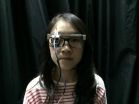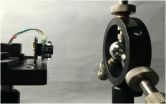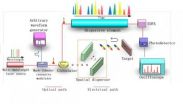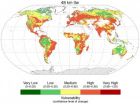(Press-News.org) WASHINGTON, July 28, 2014—A group of researchers in Taiwan has developed a new optical technology that may be able to detect an early complication of diabetes sooner, when it is more easily treated. If the device proves safe and effective in clinical trials, it may pave the way for the early detection and more effective treatment of this complication, called diabetic autonomic neuropathy, which is common among people with both Type 1 and Type 2 diabetes. The condition progressively affects the autonomic nerves controlling vital organs like the heart and gastrointestinal system. This can lead to problems like fainting, incontinence, nausea, heart arrhythmias and an increased risk of bacterial infection.
Described in a paper published today in The Optical Society (OSA)'s journal Applied Optics, the new technology is a small, wearable device called a pupillometer that can hang on a pair of eyeglasses and only weighs 78 grams, slightly heavier than Google Glass. Developed by a team at National Taiwan University Hospital, Hsin Chu branch and National Chiao-Tung University, the device is designed to be worn for a half hour or so in the doctor's office, during which time it would monitor a person's pupils. By carefully measuring five parameters associated with the pupils, doctors may then be able to detect the earliest signs of diabetic autonomic neuropathy.
Detecting someone's asymptomatic diabetic autonomic neuropathy early and treating it properly may lead to far better health outcomes for them. Currently the condition is often not detected until moderate nerve damage and organ dysfunction are present.
Currently doctors rely on observing changes in digestive speed, heart rate and blood pressure to detect diabetic autonomic neuropathy, but this limits their ability to make a diagnosis early on, said Mang Ou-Yang, who led the research with colleagues at National Chiao-Tung University. Now they have shown that monitoring the pupils of people with diabetes may be a better approach.
"Compared to the existing diagnostic techniques, the pupillometer is a more reliable, effective, portable and inexpensive solution for diagnosing diabetic autonomic neuropathy in its early stages," said Ou-Yang.
The pupil is useful for detecting diabetic autonomic neuropathy due to the neurological conditions caused by the disease. Like many organs, the eyes and pupil are dually innervated, receiving signals from both the parasympathetic and sympathetic divisions of the autonomic nervous system. These divisions control the pupil's circular and radial muscles, respectively.
The pupillometer, which is small enough to be mounted onto the front of a pair of glasses, works by emitting four colored lights to stimulate the pupil. A beam splitter attached to the device then filters the visible light that is reflected from the eye to the device's camera, which processes the images to analyze the pupil's size.
The device measures 10 parameters related to pupil diameter and response time. Of those 10, the researchers found that five parameters were significantly different in people with diabetic autonomic neuropathy.
Ou-Yang says if clinical trials are successful, the pupillometer could be available by the end of the decade.
Future research for Ou-Yang and his lab includes scaling down the size of the device, expanding the device's capabilities to observe two pupils simultaneously and collecting more experimental results from diabetic patients.
INFORMATION:
Paper: "Design and analysis of wearable pupillometer for autonomic neuropathy of diabetic patients," M.-L. Ko et al., Applied Optics, Volume 53, Issue 29, pp. H27-H34 (2014). http://www.opticsinfobase.org/ao/abstract.cfm?uri=ao-53-29-H27
EDITOR'S NOTE: Images are available to members of the media upon request. Contact Angela Stark, astark@osa.org or 202.416.1443.
About Applied Optics
Applied Optics publishes articles emphasizing applications-centered research in optics, moving the potential of science and technology to the practical. Published three times each month, Applied Optics reports significant optics applications from optical testing and instrumentation to medical optics...from holography to optical neural networks...from LIDAR and remote sensing to laser materials processing. Each issue contains content from three divisions of editorial scope: Optical Technology; Information Processing; and Lasers, Photonics and Environmental Optics. It is edited by Joseph Mait of the U.S. Army Research Laboratory. For more information, visit http://www.OpticsInfoBase.org/AO.
About OSA
Founded in 1916, The Optical Society (OSA) is the leading professional society for scientists, engineers, students and business leaders who fuel discoveries, shape real-world applications and accelerate achievements in the science of light. Through world-renowned publications, meetings and membership programs, OSA provides quality research, inspired interactions and dedicated resources for its extensive global network of professionals in optics and photonics. For more information, visit http://www.osa.org.
Wearable device for the early detection of common diabetes-related neurological condition
Hooked onto glasses, new optical device may be able to detect diabetic autonomic neuropathy sooner, leading to better treatment outcomes
2014-07-28
ELSE PRESS RELEASES FROM THIS DATE:
Potential 'universal' blood test for cancer discovered
2014-07-28
Researchers from the University of Bradford, UK, have devised a simple blood test that can be used to diagnose whether people have cancer or not.
The test will enable doctors to rule out cancer in patients presenting with certain symptoms, saving time and preventing costly and unnecessary invasive procedures such as colonoscopies and biopsies being carried out. Alternatively, it could be a useful aid for investigating patients who are suspected of having a cancer that is currently hard to diagnose.
Early results have shown the method gives a high degree of accuracy ...
Gender inequalities in health: A matter of policies
2014-07-28
A new study of the European project SOPHIE has evaluated the relationship between the type of family policies and gender inequalities in health in Europe. The results show that countries with traditional family policies (central and southern Europe) and countries with contradictory policies (Eastern Europe), present higher inequalities in self-perceived health, i.e. women reported poorer health than men. Health inequalities are especially remarkable in Southern Europe countries, where women present a 27% higher risk of having poor health compared to men.
The authors of ...
Serial time-encoded amplified microscopy for ultrafast imaging based on multi-wavelength laser
2014-07-28
Ultrafast real-time optical imaging is an effective and important tool for studying dynamical events, such as shock waves, neural activity, laser surgery and chemical dynamics in living cells. Limited by the frame rate, conventional imaging system such as charge-coupled device (CCD) and complementary metal oxide semiconductor (CMOS) imaging device can not image fast dynamic processes. Last few years, serial time-encoded amplified microscopy (STEAM) technique based on space-frequency mapping combined with frequency-time mapping has been demonstrated as a completely new optical ...
Study finds Europe's habitat and wildlife is vulnerable to climate change
2014-07-28
New research has identified areas of the Earth that are high priorities for conservation in the face of climate change.
Europe is particularly vulnerable, as it has the lowest fraction of its land area, only four per cent, of any continent in 'refugia' – areas of biological diversity that support many species where natural environmental conditions remain relatively constant during times of great environmental change. The refugia that do exist in Europe are mostly in Scandinavia and Scotland.
The biggest refugia are in the Amazon, the Congo basin, the boreal forests ...
Why do dogs smell each other's behinds? Chemical communication explained (video)
2014-07-28
WASHINGTON, July 28, 2014 — Here at Reactions, we ask the tough questions to get to the bottom of the biggest scientific quandaries. In that spirit, this week's video explains why dogs sniff each other's butts. It's a somewhat silly question with a surprisingly complex answer. This behavior is just one of many interesting forms of chemical communication in the animal kingdom. Find out more at http://www.youtube.com/watch?v=PZlJ8XfwiNg.
Subscribe to the series at Reactions YouTube, and follow us on Twitter @ACSreactions to be the first to see our latest videos.
INFORMATION:
The ...
Refrigerator magnets
2014-07-28
CAMBRIDGE, MA -- The magnets cluttering the face of your refrigerator may one day be used as cooling agents, according to a new theory formulated by MIT researchers.
The theory describes the motion of magnons — quasi-particles in magnets that are collective rotations of magnetic moments, or "spins." In addition to the magnetic moments, magnons also conduct heat; from their equations, the MIT researchers found that when exposed to a magnetic field gradient, magnons may be driven to move from one end of a magnet to another, carrying heat with them and producing a cooling ...
Children with disabilities benefit from classroom inclusion
2014-07-28
COLUMBUS, Ohio – The secret to boosting the language skills of preschoolers with disabilities may be to put them in classrooms with typically developing peers, a new study finds.
Researchers found that the average language skills of a child's classmates in the fall significantly predicted the child's language skills in the spring – especially for children with disabilities.
The results support inclusion policies in schools that aim to have students with disabilities in the same classrooms alongside their typically developing peers, said Laura Justice, co-author of the ...
Study shows new link between obesity in the young and the lowering of age of puberty
2014-07-28
A new link has been identified between obesity in childhood and the lowering of the age of puberty.
The research which discovered the link, carried out at Plymouth University Peninsula Schools of Medicine and Dentistry, is published in the Journal of Clinical Endocrinology and Metabolism.
The study focuses on a protein called sex hormone-binding globulin (SHBG), the regulation and role of which in children are poorly defined. SHBG binds to the sex hormones androgen and oestrogen. SHGB levels are initially high in childhood but decline significantly before puberty, in ...
Henry Ford study: Burnout impacts transplant surgeons
2014-07-28
VIDEO:
Despite saving thousands of lives yearly, nearly half of organ transplant surgeons report a low sense of personal accomplishment and 40 percent feel emotionally exhausted, according to a new national...
Click here for more information.
DETROIT – Despite saving thousands of lives yearly, nearly half of organ transplant surgeons report a low sense of personal accomplishment and 40% feel emotionally exhausted, according to a new national study on transplant surgeon burnout.
The ...
Many people never grow out of their growing pains
2014-07-28
Over the years, many adolescents have been forced to accept the diagnosis "growing pains" when they complained about pain in their knees. A new PhD study involving 3,000 adolescents has now shown that the knee pain often carries on:
"We can see from the study that one in three young people between the ages of 12 and 19 experience problems with pain in their knees. Seven percent of the adolescents experience daily knee pain in the front of the knee," says physiotherapist and PhD Michael Skovdal Rathleff from Aarhus University, and continues:
"More than half still have ...
LAST 30 PRESS RELEASES:
SIMJ announces global collaborative book project in commemoration of its 75th anniversary
Air pollution exposure and birth weight
Obstructive sleep apnea risk and mental health conditions among older adults
How talking slows eye movements behind the wheel
The Ceramic Society of Japan’s Oxoate Ceramics Research Association launches new international book project
Heart-brain connection: international study reveals the role of the vagus nerve in keeping the heart young
Researchers identify Rb1 as a predictive biomarker for a new therapeutic strategy in some breast cancers
Survey reveals ethical gaps slowing AI adoption in pediatric surgery
Stimulant ADHD medications work differently than thought
AI overestimates how smart people are, according to HSE economists
HSE researchers create genome-wide map of quadruplexes
Scientists boost cell "powerhouses" to burn more calories
Automatic label checking: The missing step in making reliable medical AI
Low daily alcohol intake linked to 50% heightened mouth cancer risk in India
American Meteorological Society announces Rick Spinrad as 2026 President-Elect
Biomass-based carbon capture spotlighted in newly released global climate webinar recording
Illuminating invisible nano pollutants: advanced bioimaging tracks the full journey of emerging nanoscale contaminants in living systems
How does age affect recovery from spinal cord injury?
Novel AI tool offers prognosis for patients with head and neck cancer
Fathers’ microplastic exposure tied to their children’s metabolic problems
Research validates laboratory model for studying high-grade serous ovarian cancer
SIR 2026 delivers transformative breakthroughs in minimally invasive medicine to improve patient care
Stem Cell Reports most downloaded papers of 2025 highlight the breadth and impact of stem cell research
Oxford-led study estimates NHS spends around 3% of its primary and secondary care budget on the health impacts of heat and cold in England
A researcher’s long quest leads to a smart composite breakthrough
Urban wild bees act as “microbial sensors” of city health.
New study finds where you live affects recovery after a hip fracture
Forecasting the impact of fully automated vehicle adoption on US road traffic injuries
Alcohol-related hospitalizations from 2016 to 2022
Semaglutide and hospitalizations in patients with obesity and established cardiovascular disease
[Press-News.org] Wearable device for the early detection of common diabetes-related neurological conditionHooked onto glasses, new optical device may be able to detect diabetic autonomic neuropathy sooner, leading to better treatment outcomes





